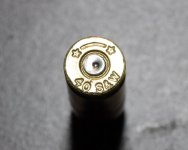"JJ"
Member
- Joined
- May 6, 2010
- Messages
- 318
- Reaction score
- 56
The reason I ask is because I watched a friend at an USPSA competition experience like 4 failures out of 100 rounds fired.
He acted like it wasn't that big of deal. There were other shooters racking thier slide as well.
He said that him and a couple of other shooters load on a dillion 650.
He also stated "that they can run 100 rds in 6 minutes!"
Now I am in research mode on a press my self to launch my reloading career.
So I am new & I am trying to get an idea of what to expect.
I have shot around 600 rds of a friends reloads & a whopping 100 rds of my own training rds with no failures.
Now I don't expect to NEVER have a failure. I am human!
But one can strive for perfection right?
My mentor taught me a precise process on a Lee Classic Turrent.
We were setting no speed records but had no failures!!
I would guess the errors go up as the speed goes up!
So my questions:
How many failures do you average/accept?
What type of failures?
What type of press?
Not trying to judge anyone or any type of press.
Its just that I'm the type of person gets down on myself if I can't get close to my goals!
If I go in expect WAY to much, I am setting myself up for failure!
Thank for any help!!
He acted like it wasn't that big of deal. There were other shooters racking thier slide as well.
He said that him and a couple of other shooters load on a dillion 650.
He also stated "that they can run 100 rds in 6 minutes!"
Now I am in research mode on a press my self to launch my reloading career.
So I am new & I am trying to get an idea of what to expect.
I have shot around 600 rds of a friends reloads & a whopping 100 rds of my own training rds with no failures.
Now I don't expect to NEVER have a failure. I am human!
But one can strive for perfection right?
My mentor taught me a precise process on a Lee Classic Turrent.
We were setting no speed records but had no failures!!
I would guess the errors go up as the speed goes up!
So my questions:
How many failures do you average/accept?
What type of failures?
What type of press?
Not trying to judge anyone or any type of press.
Its just that I'm the type of person gets down on myself if I can't get close to my goals!
If I go in expect WAY to much, I am setting myself up for failure!
Thank for any help!!

